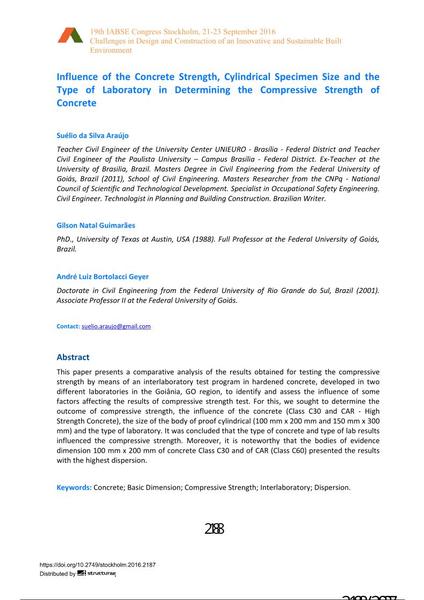Influence of the Concrete Strength, Cylindrical Specimen Size and the Type of Laboratory in Determining the Compressive Strength of Concrete

|
|
|||||||||||
Détails bibliographiques
| Auteur(s): |
Suélio da Silva Araújo
(University Center UNIEURO, Brasília, Federal District;Paulista University, Campus Brasília, Federal District.)
Gilson Natal Guimarães (PhD., University of Texas at Austin, USA (1988). Full Professor at the Federal University of Goiás, Brazil.) André Luiz Bortolacci Geyer (Doctorate in Civil Engineering from the Federal University of Rio Grande do Sul, Brazil (2001). Associate Professor II at the Federal University of Goiás.) |
||||
|---|---|---|---|---|---|
| Médium: | papier de conférence | ||||
| Langue(s): | anglais | ||||
| Conférence: | IABSE Congress: Challenges in Design and Construction of an Innovative and Sustainable Built Environment, Stockholm, Sweden, 21-23 September 2016 | ||||
| Publié dans: | IABSE Congress Stockholm, 2016 | ||||
|
|||||
| Page(s): | 2188-2201 | ||||
| Nombre total de pages (du PDF): | 14 | ||||
| Année: | 2016 | ||||
| DOI: | 10.2749/stockholm.2016.2187 | ||||
| Abstrait: |
This paper presents a comparative analysis of the results obtained for testing the compressive strength by means of an interlaboratory test program in hardened concrete, developed in two different laboratories in the Goiânia, GO region, to identify and assess the influence of some factors affecting the results of compressive strength test. For this, we sought to determine the outcome of compressive strength, the influence of the concrete (Class C30 and CAR - High Strength Concrete), the size of the body of proof cylindrical (100 mm x 200 mm and 150 mm x 300 mm) and the type of laboratory. It was concluded that the type of concrete and type of lab results influenced the compressive strength. Moreover, it is noteworthy that the bodies of evidence dimension 100 mm x 200 mm of concrete Class C30 and of CAR (Class C60) presented the results with the highest dispersion. |
||||
| Mots-clé: |
béton
|
||||
